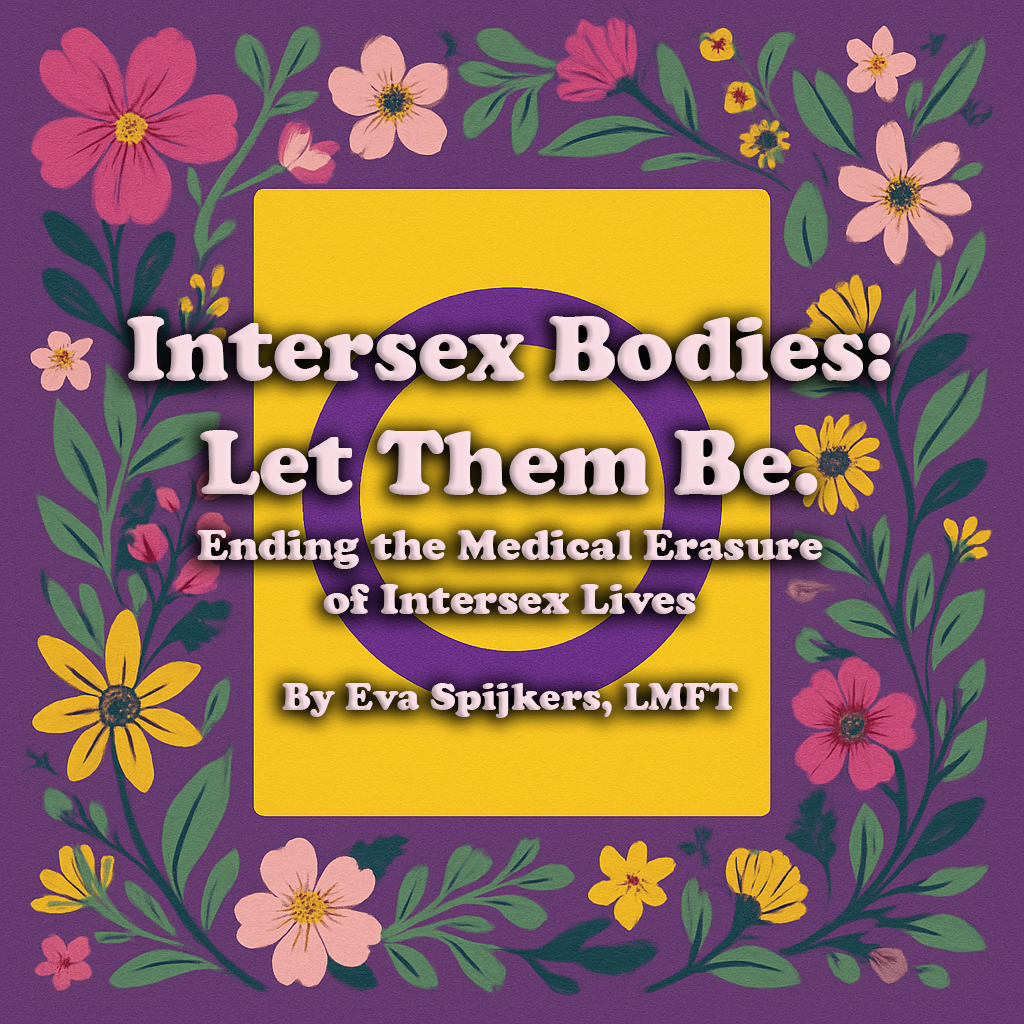Intersex Bodies: Let Them Be. Ending the Medical Erasure of Intersex Lives
By Eva Spijkers, LMFT
What if your first major surgery was performed before you could speak—before you could understand what was happening to your body, let alone consent to it? For many intersex people, this isn’t a hypothetical question, it’s their reality.
Intersex is an umbrella term describing people born with sex characteristics—genitalia, chromosomes, hormone levels—that don’t fit typical definitions of male or female. For example, some people are born with XY (“male”) chromosomes but have a vagina and breasts because their bodies don’t respond to testosterone. Others, like those with congenital adrenal hyperplasia, might have XX (“female”) chromosomes but are born with genitals that look more typically male. And in some cases, babies are born with what doctors call “ambiguous” genitalia—like having a penis and a vaginal opening, or a clitoris that’s larger than expected. Some people have a mix of chromosomes, like XXY or just a single X. These are all just ways that human bodies can develop—and they’re more common than most people think—some estimates say as frequent as 1 in 2,000 births. Intersex is as naturally occurring as red hair or left-handedness. And yet, most of us were never taught about this natural variation. What’s unnatural is the medical system’s obsession with “correcting” these bodies. We’re told that there are only two sexes, and anything else has to be changed. But that’s not science—it’s fear.
Doctors routinely perform irreversible surgeries on intersex infants and children to make their bodies appear more typically male or female. Clitoroplasty (reducing the size of a “too large” clitoris), vaginoplasty and gonad removal are all done to fit an ideal, not to address a medical emergency. These surgeries are justified with language about "normalization," but normal for whom? Parents are often told their child will be bullied or struggle socially if they don’t “look like” other boys or girls. But instead of challenging a society that bullies those who are different, we cut into children's bodies to make them fit in. We sacrifice bodily autonomy on the altar of binary gender norms. The result? Instead of helping them, these nonconsensual surgeries have left countless intersex people with lasting damage—chronic pain, infertility, sexual dysfunction, and severe psychological trauma.
When Georgiann Davis was a teenager, she went to the doctor for abdominal pain. Like many other girls her age, she was waiting for her first period. But it never came. After a series of tests, doctors told her that her ovaries were underdeveloped and posed a cancer risk; they needed to be removed ASAP. She trusted them—what choice did she have? It wasn’t until years later, when she’d needed to transfer medical records, that she discovered the truth: her removed “ovaries” weren’t ovaries at all; they were internal testes. She had XY chromosomes even though she looked female. She hadn’t been told she was intersex. Her doctor and her parents made the decision not to tell her because “chromosomal studies and most literature agrees it best she not be aware of the chromosome studies.” Her story echoes thousands of intersex people who have endured surgeries and hormone treatments without their informed consent—all to conform their bodies to a cultural script that demands every person be either “fully male” or “fully female.”
It doesn’t have to stay this way.
Intersex people are not broken. Their bodies are not medical problems that need fixing. What is broken is the system that insists difference is a crisis. The male/female binary is too small a framework to contain the full range of human variation. Instead of reshaping bodies to fit our beliefs, perhaps it’s time to reshape our beliefs to honor the bodies we’re given.
So how do we fix this? We start by ending medically unnecessary surgeries on intersex infants and children. Doctors must stop treating natural variation as pathology, and parents deserve honest, non-fear-based guidance—not pressure to choose a gender path before their child can speak. Laws should protect intersex people’s right to bodily autonomy from the beginning, just like anyone else’s. And education—starting in schools, medical training, and the media—must teach that sex is more complex than a binary.
Intersex bodies are not the problem. Our fear of difference is. It’s time we stopped letting that fear do the cutting.

